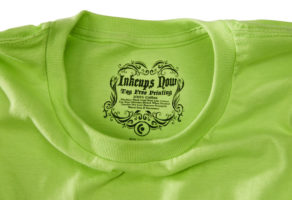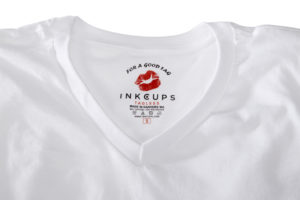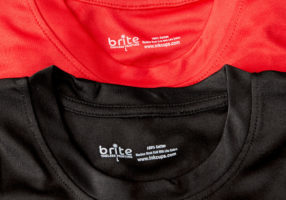The 3 largest t-shirt manufacturers in the world have made the switch to Tagless T-shirts with t-shirt label printing machines from Inkcups due to dramatic cost and time savings. Here’s a breakdown of why our tag printing machine for clothes is best:
Tagless Printing Cost savings (average numbers across our customers):
Tagless Printing Time savings:



*Brite-on-Dark with Brite-100 Printer is limited to 500 images per hour. Standard pad printers, which can use Cool Grey ink (example: red shirt above), will achieve up to 2000 impressions per hour.
Cost per high-durability printed tag ~ $.003.
Cost per high-durability label ~$.15
Cost per regular label, high volumes ~$.02
Cost per regular label, low volumes ~$.06.
$90.00 (cost of 1 ink can) ~ 100,000 tags.
$150 (average minimum order) ~ 2,500 labels.
No order minimums.
Minimum order of 2,500 labels (or 1,000 labels plus fee).
Compact and durable supplies can be easily stored in cabinets.
Funds tied up in label inventory that occupies a lot of storage space, may require cooling/air conditioning in hot climates, and gets damaged easily.
Low utility costs: air is less than 0.5 cfm, electricity is 0.87amp/10watt (per machine).
High electricity costs: 7amp per machine.
Tags withstand 50 industrial washes.
Only the high-durability types of labels withstand 50 industrial washes without breaking.
Tagless t-shirts can be stretched – good for flexible garments such as performance wear.
Only certain types of labels don’t break apart on stretching.
No heat mark (“halo”) or discoloration on fabric.
Heat marks and/or discoloration on fabrics are common.
If garment shrinks after washing, tag also shrinks.
If garment shrinks after washing, label causes unsightly dent on garment.
Tagless t-shirts stay soft-hand even after washing – great for intimate apparel.
Labels have rough texture.
Average cycle time for machine ~ 800 tags per hour.
Average cycle time for machine ~ 400 labels per hour.
Ability to change colors and graphics on demand. Brand new graphics can be ready for production in less than 20 minutes!
3- to 5-day lead time for any changes to artwork.
Ability to reduce “show through” by reducing ink laydown – great for intimate apparel.
Limited ability to control “show through”.
Supplies can be ordered on-demand.
Necessity to order a 3-month label supply and store it.
Pad printers are user-friendly and facilitate worker safety.
Burn accidents are common among heat press operators.
There is little to no waste with tagless garment printing. Leftover ink (if any) is environmentally-friendly and can be safely discarded without treatment.
Learn more about sustainability in the printing industry
Paper on both sides of every label – and that’s a lot of paper – needs to be collected and disposed of. If the paper is not recycled, it has a major negative impact on the environment.
After pad printing inside tags, there are no extra steps for drying. Tags are dry to the touch instantaneously so items can be stacked and packed/handled immediately.
After screen printing t-shirt tags, items need to be laid out to dry or dried in ovens or with air guns. These extra steps make the production process 5 to 40 times slower than with pad printing.
Pad printing uses about 10 times less ink than screen printing because ink is laid down in a very thin layer and only on the printed area.
Screen printing uses about 10 times more ink than pad printing because extra ink is spread over the whole area of the screen and the print itself is several times thicker.
No drying – no extra labor costs.
Extra labor involved in drying.
No drying – no extra utility costs.
Extra utility costs involved in drying.
Pad printing machines for clothes have a footprint several times smaller than that of screen printing machines. Drying tables/ovens are not needed.
Screen printing machines for clothes have a footprint several times larger than that of pad printing machines. Drying tables or ovens take a lot of additional space.
Prints are soft to the touch and comfortable for the consumer.
Prints are thick, hence a little rough and not as comfortable for the consumer.
| Cotton & Cotton Blends | Synthetics & Performance Fabrics | Leather | Two-End Fleece | Denim | |
|---|---|---|---|---|---|
| Home Laundering Resistance | |||||
| Industrial Laundering Resistance (50 Washes) | |||||
| Stretchable | |||||
| Soft-Touch | |||||
| 1-Color | |||||
| 2-Colors | |||||
| Anti-Dye Migration |
| Cotton & Cotton Blends | Synthetics & Performance Fabrics | Leather | Two-End Fleece | Denim | |
|---|---|---|---|---|---|
| Custom Color | |||||
| Bright White on Dark | |||||
| Gray on Dark | |||||
| Metallic |
| Cotton & Cotton Blends | Synthetics & Performance Fabrics | Leather | Two-End Fleece | Denim | |
|---|---|---|---|---|---|
| Oeko-Tex 100 Class 1/RSL | |||||
| Adidas A01 | |||||
| Nike RSL | |||||
| CPSIA |